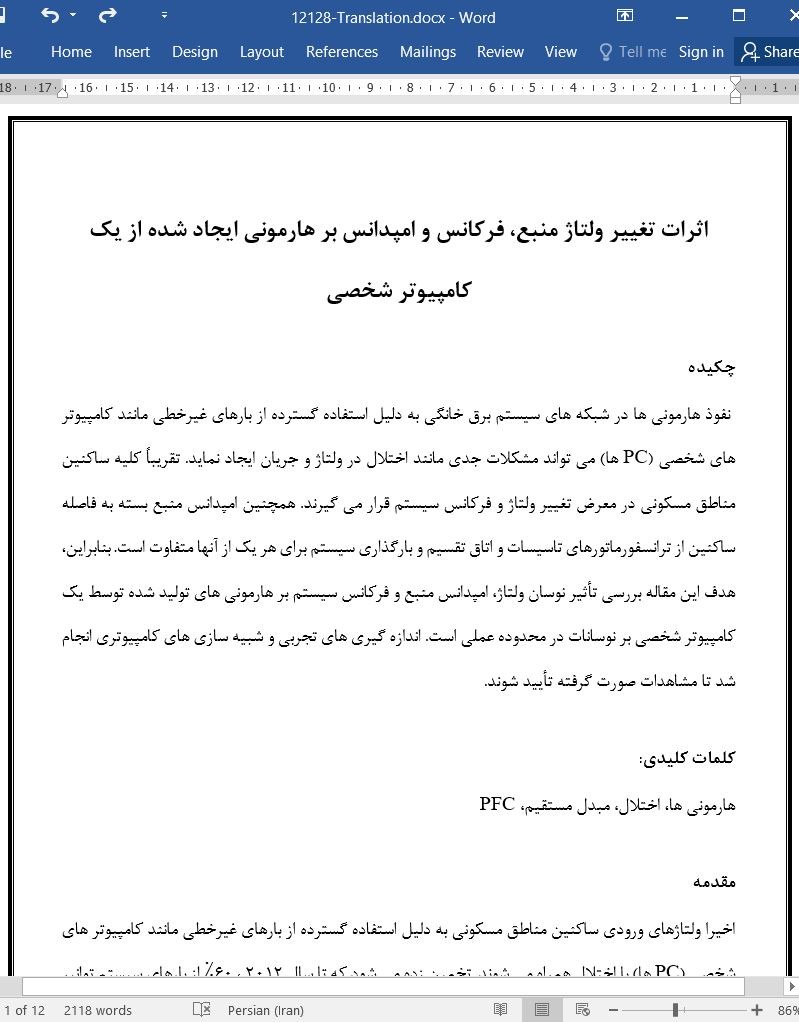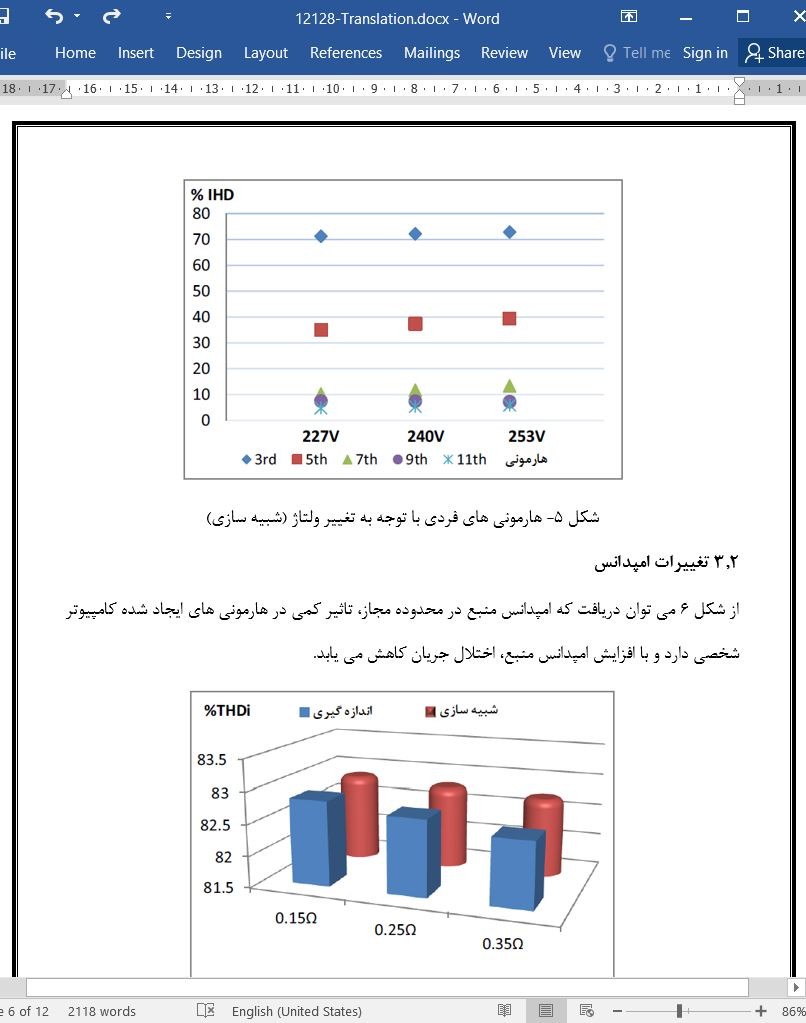
اثرات تغییر ولتاژ منبع، فرکانس و امپدانس بر هارمونی ایجاد شده از یک کامپیوتر شخصی
چکیده
نفوذ هارمونی ها در شبکه های سیستم برق خانگی به دلیل استفاده گسترده از بارهای غیرخطی مانند کامپیوتر های شخصی (PC ها) می تواند مشکلات جدی مانند اختلال در ولتاژ و جریان ایجاد نماید. تقریباً کلیه ساکنین مناطق مسکونی در معرض تغییر ولتاژ و فرکانس سیستم قرار می گیرند. همچنین امپدانس منبع بسته به فاصله ساکنین از ترانسفورماتورهای تاسیسات و اتاق تقسیم و بارگذاری سیستم برای هر یک از آنها متفاوت است. بنابراین، هدف این مقاله بررسی تأثیر نوسان ولتاژ، امپدانس منبع و فرکانس سیستم بر هارمونی های تولید شده توسط یک کامپیوتر شخصی بر نوسانات در محدوده عملی است. اندازه گیری های تجربی و شبیه سازی های کامپیوتری انجام شد تا مشاهدات صورت گرفته تأیید شوند.
مقدمه
اخیرا ولتاژهای ورودی ساکنین مناطق مسکونی به دلیل استفاده گسترده از بارهای غیرخطی مانند کامپیوتر های شخصی (PC ها) با اختلال همراه می شوند. تخمین زده می شود که تا سال 2012 ، 60٪ از بارهای سیستم توانیر در آمریکا بارهای غیرخطی خواهد بود [1]. نفوذ هارمونی ها در شبکه های سیستم برق مسکونی می تواند مشکلات جدی از جمله کاهش ضریب توان، افزایش اختلال در ولتاژ، افزایش تداخل در شبکه های ارتباطی، اندازه گیری انرژی ضربه، افزایش تلفات سیستم و کاهش راندمان کلی سیستم ایجاد کند [2-7].
نتیجه گیری
در نتیجه می توان گفت که نوسانات ولتاژ منبع باعث می شود تا THDi، هارمونی های فردی، ضریب توان، توان فعال و غیرفعال دچار تغییر شوند. افزایش ولتاژ منبع THDi باعث افزایش توان فعال، توان غیرفعال و توان ظاهری و کاهش ضریب توان می شود. اندازه گیری عملی نشان می دهد که اگرچه اکثر جریان های هارمونی فردی با افزایش ولتاژ منبع افزایش می یابند، اما ممکن است برخی از هارمونی ها دچار کاهش شوند. علاوه بر این، همه اندازه گیری ها و شبیه سازی ها نشان می دهد که تغییرات جریان برای یکی از ساکنین در مناطق مسکونی با توجه به امپدانس منبع و تغییر فرکانس سیستم در محدوده مقرر ناچیز است. با این حال، با افزایش امپدانس منبع و فرکانس سیستم، اختلال جریان کمی کاهش می یابد.
Abstract
The penetration of harmonics in residential power system networks due to the widespread use of nonlinear loads such as Personal Computers (PCs) can cause severe problems including voltage and current distortion. Almost all residential customers are subjected to variations in the system voltage and frequency. Also, the source impedance is different for different customers depending on their distance from the utility transformers and distribution cabinets and the system loading. Hence, the purpose of this paper is to investigate the effects of the voltage amplitude, source impedance and system frequency on the harmonics produced by a single PC for variations within practical limits. Experimental measurements and computer simulations are performed to confirm the observations.
1 Introduction
Recently, residential customer¶s input voltages are becoming more distorted due to the widespread use of nonlinear loads such as Personal Computers (PCs). It has been estimated that by 2012, 60% of the loads on power system in USA will be nonlinear loads [1]. The penetration of harmonics in residential power system networks can cause severe problems such as decrease in power factor, increase in voltage distortion, increased interference with communications networks, impact energy metering, increase system losses and decrease the overall system efficiency [2-7].
5 Conclusion
In conclusion, source voltage fluctuation causes THDi, individual harmonics, power factor, active and nonactive power to be changed. Increasing the source voltage increases THDi, active, nonactive and apparent power and the power factor decreases. Practical measurement shows that although most of the individual harmonic current increase with increasing source voltage, some harmonics might decrease. Furthermore, all measurements and simulations show that current distortion variations for a residential customer are negligible for source impedance and system frequency change within prescribed limits. However, current distortion slightly decreases as source impedance and system frequency increase.
چکیده
1. مقدمه
2. ابزار تست و مدل سازی بار
3. محاسبه هارمونی ها و نتایج
3.1 تغییرات ولتاژ
3.2 تغییرات امپدانس
3.3 تغییرات فرکانس
4. تأثیر تغییرات Vs ، Zs و F بر سایر کمیت های توان
5. نتیجه گیری
منابع
Abstract
1 .Introduction
2 .Test rig and load modelling
3. Harmonics quantification and results
3.1 .Voltage variation
3.2 .Impedance variation
3.3. Frequency variation
4. Effects of Vs, Zs and F variation on other power quantities
5. Conclusion
References
- اصل مقاله انگلیسی با فرمت ورد (word) با قابلیت ویرایش
- ترجمه فارسی مقاله با فرمت ورد (word) با قابلیت ویرایش، بدون آرم سایت ای ترجمه
- ترجمه فارسی مقاله با فرمت pdf، بدون آرم سایت ای ترجمه



